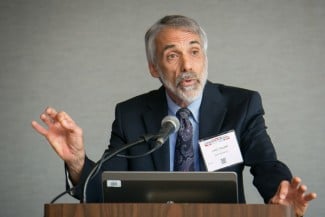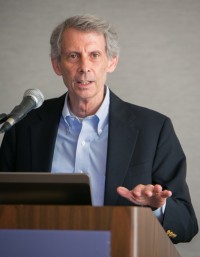Crime rate not main reason prison population exploded: It was sentencing policy

Marc Mauer, executive director of the Sentencing Project. All photos by ©Kathy Anderson.
Suppose that in 1972, in response to a rising crime rate, then-President Richard Nixon announced plans to build 1 million new prison cells, reserve 60 percent of them for blacks and Latinos and put 3,000 people on death row, said Marc Mauer, executive director of the Sentencing Project.
Such an announcement, which never happened, would have provoked widespread outrage, Mauer said. But the nation’s criminal justice policies over the past 40-some years have had that very effect.

Former Deputy Attorney General James Cole.
Today, the United States is the world’s leader in incarceration, with more than 2.2 million people behind bars. More than 1,000 have been executed since the U.S. Supreme Court reinstated capital punishment in 1976. One in nine of those in prison are serving life sentences without possible parole. And there are more people incarcerated for drug offenses today than the entire prison population in 1980, Mauer said.
That scenario helped set the stage on Saturday for a wide-ranging discussion of the nation’s criminal justice and sentencing policies at a Presidential Showcase Program at the ABA Annual Meeting. “Mass Incarceration: A Nation Behind Bars” was sponsored by the ABA Criminal Justice Section.
Mauer was one of four panelists who explored the social, political and financial costs—as well as the collateral consequences to individuals, families and society—of the explosion in lengthy prison sentences over the past 40 years or so. Other panelists included former Deputy Attorney General James Cole; Sherrilyn Ifill, president and director-counsel of the NAACP Legal Defense & Educational Fund; and John Hagan, a professor of sociology and law at Northwestern University.

John Hagan, a professor of sociology and law at Northwestern University.
Mauer said the explosion in the prison population has come about primarily through changes in policy, not crime rates. Sentencing policies adopted in the 1980s and ’90s were designed to send more people to prison and to keep them incarcerated for longer periods of time.
The good news, he said, is that we’re finally seeing the beginnings of a shift away from such harsh sentencing policies in Congress and in many states. “Many of us are more optimistic about the prospects for reform now than we’ve been in a long time,” he said.
Cole, now a partner at the Washington, D.C., firm Sidley & Austin, said the root of the problem was the idea that by taking all criminals off the streets for a long period of time we would solve the crime problem. “Crime did go down,” he said, “but we have to ask ourselves at what cost and with what unintended consequences that we now have to live with.”

Sherrilyn Ifill, president and director-counsel of the NAACP Legal Defense & Educational Fund.
Hagan said that half of all the adults incarcerated in America have kids, which has all sorts of negative consequences for those children, who are the innocent victims of the crimes of their parents. He said he too sees hope for the future, but that “it’s going to take a lot of hard work by a lot of people to get it done.”
Ifill said it is not only time for a careful look at what caused the current crisis, it’s also the time to initiate an affirmative effort to eradicate implied or perceived racial bias from the criminal justice system. And she said lawyers have a special role to play in that process.
“We must take immediate action,” she said, “to begin the process of rebuilding trust and confidence in the criminal justice system, and fulfilling the promise of equal justice.”
• See what people are saying about the events on social media, and follow along with our full coverage of the 2015 ABA Annual Meeting.



